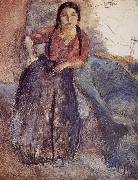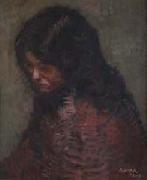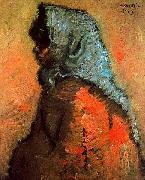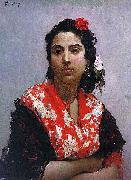Wholesale Oil Painting Reproductions No Minimum and Door to Door! |
|||||||||||
|
|
|||||||||||

|
|||||||||||
|
|
|
||||||||
All Jules Pascin Oil Paintings |
||||||||
|
|
||||||||
|
|
||||||||
|
Artist Introduction: Bulgarian-born French Expressionist Painter, 1885-1930,American painter, draughtsman and printmaker of Bulgarian birth, active in France. He attended secondary school in Vienna, returning in 1901 to Bucharest, where his family had settled, and working briefly in the office of his father's grain-merchandizing business. He was, however, already becoming passionately interested in drawing, for which he showed precocious talent. At the age of 16 he became the lover of a woman who ran a brothel and was allowed by her to draw the residents. In 1903 he moved to Munich, where he attended the art school run by Moritz Heymann. |
||||||||
|
|
||||||||
|
Gitana Painting ID:: 51455 |
mk219
Oil on canvas
72x60cm
|
|||||||
Height Width |
INS/CM Quality |
|||||||
|
X |
| |||||||
|
|
||||||||
All Raimundo Madrazo Oil Paintings |
||||||||
|
|
||||||||
|
|
||||||||
|
Artist Introduction: (1841, Rome - 1920) was a Spanish realist painter.
He studied painting under his father, Federico de Madrazo, and at the School of the Beaux Arts in Madrid. After 1860 he lived mostly in Paris, where he studied under L??on Cogniet. His remarkable technical ability made him a highly successful portrait painter in a Salon style.
|
||||||||
|
|
||||||||
|
|
Gitana Painting ID:: 87498 |
Oil on canvas
cjr |
||||||
Height Width |
INS/CM Quality |
|||||||
|
X |
| |||||||
|
|
||||||||
All Isidre Nonell Oil Paintings |
||||||||
|
|
||||||||
|
|
||||||||
|
Artist Introduction: (November 30, 1873, Barcelona, Spain - February 21, 1911, Barcelona) a Catalonian painter and drawer belonging to post-impressionism known for his expressive portrayal of the socially marginalized of Barcelona society. (He is also said to belong to modernism and postmodernism.)
Isidre Nonell was born in 1872 (not in 1873 as indicated by some biographers). His parents, Isidre Nonell i Torras de Arenys de Mar and Àngela Monturiol i Franc of Barcelona, owned a small but prosperous factory of soup noodles. Together with his childhood friend, Joaquim Mir, with whom he attended the same school in the neighborhood of Sant Pere in the old part of town in Barcelona, he developed artistic ambitions at an early age.
His early teachers included Josep Mirabent, Gabriel Martenez Alt and Llu Graner. From 1893 to 1895 he studied at the Escola de Belles Arts de Barcelona (Fine Arts School of Barcelona). He met Ricard Canals, Ramen Pichot, Juli Vallmitjana, Adrie Gual, and Joaquin Sunyer with whom he developed an interest in landscape painting, studying light. The study of sunlight and its effects on color were a main part of Impressionism, which was then active. They were called the "Saffron Group" for the warm tones they used, as well as the "Sant Marte Group" after the town they painted in.
In 1894, he began producing illustrations for La Vanguardia. He later drew for other periodicals, including LeEsquella de la Torratxa, Barcelona Cemica, Pel & Ploma, and Forma.
In 1896, Nonell went with Ricard Canals and Juli Vallmitjana to the spa town of Caldes de Boe in the Catalonian Pyrenees to work at the spa run by Vallmitjana's family. There, he saw a large number of people suffering from the illness of cretinism, which became a subject of his paintings.
In February 1897, he went to Paris with Ricard Canals. There he exhibited and shared a studio with Picasso. He returned to Barcelona in 1900. At the beginning of 1901, he made paintings of women, such as gypsy and working-class women, and still lifes. He exhibited in the Sala Par in Barcelona twice, in 1902 and 1903. The reaction to his works of poor gypsy women was very hostile.
|
||||||||
|
|
||||||||
|
|
Gitana Painting ID:: 88066 |
1907(1907)
Medium Oil on canvas
Dimensions 60 x 50 cm (23.6 x 19.7 in)
cjr |
||||||
Height Width |
INS/CM Quality |
|||||||
|
X |
| |||||||
|
|
||||||||
All Isidre Nonell Oil Paintings |
||||||||
|
|
||||||||
|
|
||||||||
|
Artist Introduction: (November 30, 1873, Barcelona, Spain - February 21, 1911, Barcelona) a Catalonian painter and drawer belonging to post-impressionism known for his expressive portrayal of the socially marginalized of Barcelona society. (He is also said to belong to modernism and postmodernism.)
Isidre Nonell was born in 1872 (not in 1873 as indicated by some biographers). His parents, Isidre Nonell i Torras de Arenys de Mar and Àngela Monturiol i Franc of Barcelona, owned a small but prosperous factory of soup noodles. Together with his childhood friend, Joaquim Mir, with whom he attended the same school in the neighborhood of Sant Pere in the old part of town in Barcelona, he developed artistic ambitions at an early age.
His early teachers included Josep Mirabent, Gabriel Martenez Alt and Llu Graner. From 1893 to 1895 he studied at the Escola de Belles Arts de Barcelona (Fine Arts School of Barcelona). He met Ricard Canals, Ramen Pichot, Juli Vallmitjana, Adrie Gual, and Joaquin Sunyer with whom he developed an interest in landscape painting, studying light. The study of sunlight and its effects on color were a main part of Impressionism, which was then active. They were called the "Saffron Group" for the warm tones they used, as well as the "Sant Marte Group" after the town they painted in.
In 1894, he began producing illustrations for La Vanguardia. He later drew for other periodicals, including LeEsquella de la Torratxa, Barcelona Cemica, Pel & Ploma, and Forma.
In 1896, Nonell went with Ricard Canals and Juli Vallmitjana to the spa town of Caldes de Boe in the Catalonian Pyrenees to work at the spa run by Vallmitjana's family. There, he saw a large number of people suffering from the illness of cretinism, which became a subject of his paintings.
In February 1897, he went to Paris with Ricard Canals. There he exhibited and shared a studio with Picasso. He returned to Barcelona in 1900. At the beginning of 1901, he made paintings of women, such as gypsy and working-class women, and still lifes. He exhibited in the Sala Par in Barcelona twice, in 1902 and 1903. The reaction to his works of poor gypsy women was very hostile.
|
||||||||
|
|
||||||||
|
|
Gitana Painting ID:: 90160 |
1909(1909)
Medium oil on canvas
Dimensions 74 x 60 cm (29.1 x 23.6 in)
cjr |
||||||
Height Width |
INS/CM Quality |
|||||||
|
X |
| |||||||
|
|
||||||||
All Raimundo Madrazo Oil Paintings |
||||||||
|
|
||||||||
|
|
||||||||
|
Artist Introduction: (1841, Rome - 1920) was a Spanish realist painter.
He studied painting under his father, Federico de Madrazo, and at the School of the Beaux Arts in Madrid. After 1860 he lived mostly in Paris, where he studied under L??on Cogniet. His remarkable technical ability made him a highly successful portrait painter in a Salon style.
|
||||||||
|
|
||||||||
|
|
Gitana Painting ID:: 92254 |
oil on canvas
cyf |
||||||
Height Width |
INS/CM Quality |
|||||||
|
X |
| |||||||
|
|
||||||||
|
Prev Next
|
||||||||
|
|
||||||||
|
Related Paintings to Raimundo Madrazo :. |
||||||||
|
|
||||||||
|
CONTACT US |





